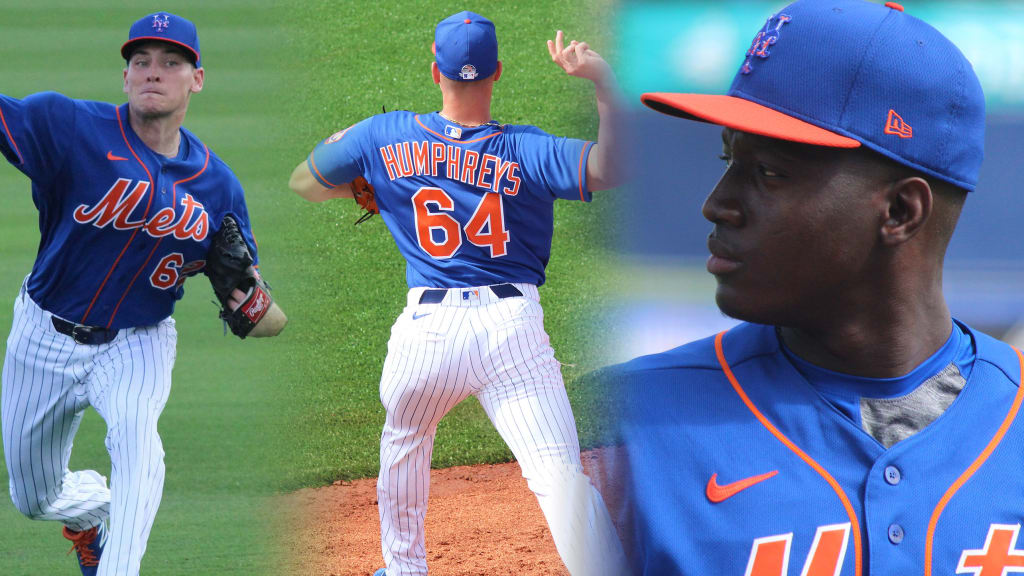
PORT ST. LUCIE, Fla. -- It was early last summer when Jordan Humphreys grew frustrated enough with his rehab from Tommy John surgery that he considered retiring. A former 17th-round Draft pick, Humphreys was raising two kids on a Minor League salary. His initial rehab did not go smoothly, necessitating a second operation to reposition a nerve in his forearm. There were days, he said, “when I didn’t even want to pick up a baseball, it hurt so bad.”
As Humphreys weighed giving up, rehab pitching coordinator Jon Debus sat him down and mapped out a plan. Debus urged patience, telling Humphreys he would be throwing by June, would participate in the Arizona Fall League in September and would be on the Mets’ 40-man roster by November. Skeptical, Humphreys relented. Back to the grind he returned.
His story may be dramatic, but it is not unusual in a game that sees Tommy John surgeries pop up each year. Four of the 35 pitchers in Mets camp -- Humphreys, Drew Smith, Franklyn Kilomé and Thomas Szapucki -- spent last summer recovering from Tommy John. Quite a few others, including rotation members Jacob deGrom and Steven Matz, are alumni of the operation. They have formed something of a club in the clubhouse, understanding how difficult recovery from the surgery can be.
“Most of the time, you see all the success stories, not necessarily the guys that have had the setbacks and all the other stuff that goes along with it,” Humphreys said. “The mental state is definitely the toughest thing you have to get through. … You’ve just got to look at the end of the tunnel, there’s light.”
Summer days, summer nights
For pitchers recovering from Tommy John, the rehab schedule begins early in the morning. The first eight weeks, Smith said, are the most painful, because throwing is off limits. Instead, pitchers go through tedious exercises to re-establish range of motion in their elbows -- day in, day out.
Even once pitchers begin throwing at the four- to five-month mark, it can be several more months before they advance to more intensive flat-ground work, then eventually bullpen sessions. In Smith’s case, it took nearly 11 months before the Mets cleared him to throw off a mound.
“I kind of struggled with it at first, just what to do,” Smith said.
Smith and Humphreys became “movie connoisseurs,” seeing film after film at a local theater, but that still left hours of empty time each day. It was not until Smith’s agent shipped him a box of books that he settled into a rhythm. One of the books was “Relentless,” by Tim Grover, a trainer who has worked with Michael Jordan, Kobe Bryant, Dwyane Wade and others. Another was “The MVP Machine” by Ben Lindbergh and Travis Sawchik, about baseball analytics. Suddenly, Smith, who hadn’t opened a book since leaving college in 2015, was an avid reader.
Kilomé filled the time playing video games -- mostly his favorite, “Call of Duty.” Szapucki, who grew up less than an hour from the Mets’ Spring Training complex, spent the hours hanging with friends.
Humphreys had the most difficult path, given his rougher rehab. When he wasn’t spending time with Smith, or driving three-plus hours across the state to be with his family, he often went to Debus' home. There the rehab coordinator cooked for Humphreys and let him fish on the beach abutting his condo complex. Some days, Humphreys liked to talk about his rehab. Other days, he wanted to keep his mind as far away from it as possible.
“You’re at a pretty low point in your life, in your career,” Humphreys said. “You don’t know if you’re ever going to get on the field again. You get to talking with these guys. Everybody kind of uplifts you. It’s your only way to get by.”
Finally healthy
Throughout the long summer, Kilomé said, he repeated the same mantra to himself each morning.
“Every time you just wake up and say, ‘Today is a new day to get closer to being healthy,’” said Kilomé, the Mets’ 10th-ranked prospect according to MLB Pipeline.
Kilomé is healthy now, about 16 months removed from his surgery. So is Szapucki, the Mets’ 12th-ranked prospect, who returned to games on a limited basis early last summer. Smith has thrown a handful of bullpen sessions this spring, and is the best bet of the four to see time in the big leagues this season.
Then there is Humphreys, the Mets’ 22nd-ranked prospect. He endured another setback last summer but began throwing late in the year and, as Debus envisioned, posted a 0.77 ERA over four relief appearances in the AFL. About two months later, Jared Banner, the executive director of player development, called Humphreys to inform him that the Mets had placed him on the 40-man roster -- insuring not only an invitation to big league camp but a realistic chance at fulfilling his dream.
That was no given for a player in his situation. During the call, Humphreys grew emotional, choking up to the point where the conversation ended quickly. Three months later he reported to his first big league camp, the interminable two-and-a-half-year grind behind him.
“I’m glad to be here,” Humphrey said. “I’m finally healthy.”


